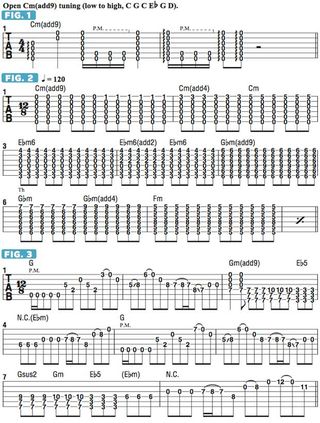Using Unusual Tunings to Create Fresh, Unique Riffs

A songwriting device I find very useful and inspiring and have explored extensively is to use alternate tunings.
One of the more unusual altered tunings I’ve employed is what I refer to as open Cm(add9), which is, low to high, C G C Eb G D. For the Periphery song “Scarlet,” we use a very similar tuning, open Cadd9 (low to high, C G C E G D).
While writing new music for my other band Haunted Shores, my bandmates and I decided to try a minor version of this tuning, wherein the third of C, E, the open third string, is tuned down an additional half step to the minor, or “flatted,” third, Eb.
Open Cadd9 tuning has a happy, jovial, “fluffy” quality, but Cm(add9) sounds very dark and foreboding, which I find very appealing. This is the tuning I use for the Haunted Shores song “Norway Jose,” among others. In fact, it serves as the focal point of 2015’s Viscera album.
FIGURE 1 illustrates Cm(add9) tuning, as I strum across all of the open strings. The combination of the flatted third, Eb, sounded along with the ninth, D on top, combined with the detuning of sixth, third and second strings two whole steps, yields a very deep and menacing sound. FIGURE 2 illustrates the opening phrases in “Norway Jose.” The song is played in 12/8 meter, which has a swinging, triplet-based feel: one-trip-let, two-trip-let, three-trip-let, four-trip-let. I begin by simply strumming across all six open strings, after which I add ascending melody notes on the first string.
I apply a similar approach in bars 3 and 4, as I begin with Ebm6 and then ascend to progressively higher notes on the third string. This approach is employed further in bars 5 and 6, starting with a Gbm(add9) voicing, with ascending melody notes again played on the first string. Another approach I take with this tuning is to “go riffy,” meaning to move away from chord sounds and instead devise single-note lines. FIGURE 3 presents the chorus of “Norway Jose.” In bars 1 and 2, I circle around a G major sound and include the b9 (flatted ninth), Ab. In bar 3, I switch to a Gm(add9) sound. The four-bar pattern then repeats, starting in bar 5, although, in the third bar of the pattern, I omit what was originally played on beat one, effectively shifting the remainder of the phrase back a beat, meaning earlier.
If you haven’t experimented with alternate tunings, I encourage you to do so! It’s a great way to spark fresh-sounding musical ideas. In my experience, this always leads to unexpected, satisfying results. I periodically fall into a creative rut, and the best way to get out of it is to try writing new music in an open tuning. You can use tunings that your favorite guitarists have employed in the past or invent your own. This is my final installment of Holcomb Mania for now. I hope you enjoyed these lessons and found the musical concepts I’ve shared to be useful in your own guitar playing and writing endeavors. See you out on the road!
Holcomb-Mania June 2016 FIGURE 1
Holcomb-Mania June 2016 FIGURE 2
Holcomb-Mania June 2016 FIGURE 3

Get The Pick Newsletter
All the latest guitar news, interviews, lessons, reviews, deals and more, direct to your inbox!

Want to play Master of Puppets the right way? Here's how to get faster at downpicking so you can chug like James Hetfield

“A few poorly intonated sustained bends in a solo can make the guitar's most emotive technique sound bad”: Learning how to bend strings correctly is one of the quickest ways to make your playing sound better


![Joe Bonamassa [left] wears a deep blue suit and polka-dotted shirt and plays his green refin Strat; the late Irish blues legend Rory Gallagher [right] screams and inflicts some punishment on his heavily worn number one Stratocaster.](https://cdn.mos.cms.futurecdn.net/cw28h7UBcTVfTLs7p7eiLe-840-80.jpg)






